History of rail transport
The history of rail transport began in the 6th century BC in Ancient Greece. It can be divided into several discrete periods defined by the principal means of track material and motive power used.
Ancient systems
Evidence indicates that there was a 6 to 8.5 km long Diolkos paved trackway, which transported boats across the Isthmus of Corinth in Greece from around 600 BC.[1][2][3][4][5] Wheeled vehicles pulled by men and animals ran in grooves in limestone, which provided the track element, preventing the wagons from leaving the intended route. The Diolkos was in use for over 650 years, until at least the 1st century AD.[5] Paved trackways were also later built in Roman Egypt.[6][7]
Pre-steam
Wooden rails introduced

In 1515, Cardinal Matthäus Lang wrote a description of the Reisszug, a funicular railway at the Hohensalzburg Fortress in Austria. The line originally used wooden rails and a hemp haulage rope and was operated by human or animal power, through a treadwheel.[8] The line still exists and remains operational, although in updated form. It may be the oldest operational railway.[9]
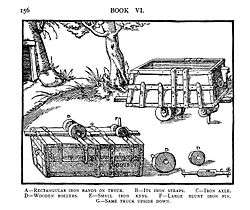
Wagonways (or tramways), with wooden rails and horse-drawn traffic, are known to have been used in the 1550s to facilitate transportation of ore tubs to and from mines. They soon became popular in Europe and an example of their operation was illustrated by Georgius Agricola (image left) in his 1556 work De re metallica.[10] This line used "Hund" carts with unflanged wheels running on wooden planks and a vertical pin on the truck fitting into the gap between the planks to keep it going the right way. The miners called the wagons Hunde ("dogs") from the noise they made on the tracks.[11] There are many references to wagonways in central Europe in the 16th century.[12]
A wagonway was introduced to England by German miners at Caldbeck, Cumbria, possibly in the 1560s.[13] A wagonway was built at Prescot, near Liverpool, sometime around 1600, possibly as early as 1594. Owned by Philip Layton, the line carried coal from a pit near Prescot Hall to a terminus about half a mile away.[14] A funicular railway was made at Broseley in Shropshire some time before 1604. This carried coal for James Clifford from his mines down to the river Severn to be loaded onto barges and carried to riverside towns.[15] The Wollaton Wagonway, completed in 1604 by Huntingdon Beaumont, has sometimes erroneously been cited as the earliest British railway. It ran from Strelley to Wollaton near Nottingham.[16]
The Middleton Railway in Leeds, which was built in 1758, later became the world's oldest operational railway (other than funiculars), albeit now in an upgraded form. In 1764, the first railway in America was built in Lewiston, New York.[17]
Metal rails introduced
The introduction of steam engines for powering blast air to blast furnaces led to a large increase in British iron production after the mid 1750s.[18]:123–25
In the late 1760s, the Coalbrookdale Company began to fix plates of cast iron to the upper surface of wooden rails, which increased their durability and load-bearing ability. At first only balloon loops could be used for turning wagons, but later, movable points were introduced that allowed passing loops to be created.[19]

A system was introduced in which unflanged wheels ran on L-shaped metal plates – these became known as plateways. John Curr, a Sheffield colliery manager, invented this flanged rail in 1787, though the exact date of this is disputed. The plate rail was taken up by Benjamin Outram for wagonways serving his canals, manufacturing them at his Butterley ironworks. In 1803, William Jessop opened the Surrey Iron Railway, a double track plateway, sometimes erroneously cited as world's first public railway, in south London.[20]
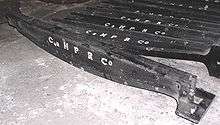
In 1789, William Jessop had introduced a form of all-iron edge rail and flanged wheels for an extension to the Charnwood Forest Canal at Nanpantan, Loughborough, Leicestershire. In 1790, Jessop and his partner Outram began to manufacture edge-rails. Jessop became a partner in the Butterley Company in 1790. The first public edgeway (thus also first public railway) built was the Lake Lock Rail Road in 1796. Although the primary purpose of the line was to carry coal, it also carried passengers.
These two systems of constructing iron railways, the "L" plate-rail and the smooth edge-rail, continued to exist side by side into the early 19th century. The flanged wheel and edge-rail eventually proved its superiority and became the standard for railways.
Cast iron was not a satisfactory material for rails because it was brittle and broke under heavy loads. The wrought iron rail, invented by John Birkinshaw in 1820, solved these problems. Wrought iron (usually simply referred to as "iron") was a ductile material that could undergo considerable deformation before breaking, making it more suitable for iron rails. But wrought iron was expensive to produce until Henry Cort patented the puddling process in 1784. In 1783, Cort also patented the rolling process, which was 15 times faster at consolidating and shaping iron than hammering.[21] These processes greatly lowered the cost of producing iron and iron rails. The next important development in iron production was hot blast developed by James Beaumont Neilson (patented 1828), which considerably reduced the amount of coke (fuel) or charcoal needed to produce pig iron.[22] Wrought iron was a soft material that contained slag or dross. The softness and dross tended to make iron rails distort and delaminate and they typically lasted less than 10 years in use, and sometimes as little as one year under high traffic. All these developments in the production of iron eventually led to replacement of composite wood/iron rails with superior all-iron rails.
The introduction of the Bessemer process, enabling steel to be made inexpensively, led to the era of great expansion of railways that began in the late 1860s. Steel rails lasted several times longer than iron.[23][24][25] Steel rails made heavier locomotives possible, allowing for longer trains and improving the productivity of railroads.[26] The Bessemer process introduced nitrogen into the steel, which caused the steel to become brittle with age. The open hearth furnace began to replace the Bessemer process near the end of 19th century, improving the quality of steel and further reducing costs. Steel completely replaced the use of iron in rails, becoming standard for all railways.
Steam power introduced
James Watt, a Scottish inventor and mechanical engineer, greatly improved the steam engine of Thomas Newcomen, hitherto used to pump water out of mines. Watt developed a reciprocating engine in 1769, capable of powering a wheel. Although the Watt engine powered cotton mills and a variety of machinery, it was a large stationary engine. It could not be otherwise: the state of boiler technology necessitated the use of low pressure steam acting upon a vacuum in the cylinder; this required a separate condenser and an air pump. Nevertheless, as the construction of boilers improved, Watt investigated the use of high-pressure steam acting directly upon a piston. This raised the possibility of a smaller engine, that might be used to power a vehicle and he patented a design for a steam locomotive in 1784. His employee William Murdoch produced a working model of a self-propelled steam carriage in that year.[27]
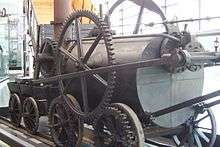
The first full-scale working railway steam locomotive was built in the United Kingdom in 1804 by Richard Trevithick, a British engineer born in Cornwall. This used high-pressure steam to drive the engine by one power stroke. The transmission system employed a large flywheel to even out the action of the piston rod. On 21 February 1804, the world's first steam-powered railway journey took place when Trevithick's unnamed steam locomotive hauled a train along the tramway of the Penydarren ironworks, near Merthyr Tydfil in South Wales.[28][29] Trevithick later demonstrated a locomotive operating upon a piece of circular rail track in Bloomsbury, London, the Catch Me Who Can, but never got beyond the experimental stage with railway locomotives, not least because his engines were too heavy for the cast-iron plateway track then in use.[30]
.jpg)
The first commercially successful steam locomotive was Matthew Murray's rack locomotive Salamanca built for the Middleton Railway in Leeds in 1812. This twin-cylinder locomotive was not heavy enough to break the edge-rails track and solved the problem of adhesion by a cog-wheel using teeth cast on the side of one of the rails. Thus it was also the first rack railway.
This was followed in 1813 by the locomotive Puffing Billy built by Christopher Blackett and William Hedley for the Wylam Colliery Railway, the first successful locomotive running by adhesion only. This was accomplished by the distribution of weight between a number of wheels. Puffing Billy is now on display in the Science Museum in London, making it the oldest locomotive in existence.[31]
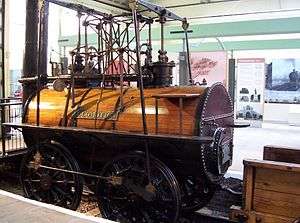
In 1814 George Stephenson, inspired by the early locomotives of Trevithick, Murray and Hedley, persuaded the manager of the Killingworth colliery where he worked to allow him to build a steam-powered machine. Stephenson played a pivotal role in the development and widespread adoption of the steam locomotive. His designs considerably improved on the work of the earlier pioneers. He built the locomotive Blücher, also a successful flanged-wheel adhesion locomotive. In 1825 he built the locomotive Locomotion for the Stockton and Darlington Railway in the north east of England, which became the first public steam railway in the world, although it used both horse power and steam power on different runs. In 1829, he built the locomotive Rocket, which entered in and won the Rainhill Trials. This success led to Stephenson establishing his company as the pre-eminent builder of steam locomotives for railways in Great Britain and Ireland, the United States, and much of Europe.[32]:24–30[33] The first public railway which used only steam locomotives, all the time, was Liverpool and Manchester Railway, built in 1830.
Steam power continued to be the dominant power system in railways around the world for more than a century.
Electric power introduced
The first known electric locomotive was built in 1837 by chemist Robert Davidson of Aberdeen in Scotland, and it was powered by galvanic cells (batteries). Thus it was also the earliest battery electric locomotive. Davidson later built a larger locomotive named Galvani, exhibited at the Royal Scottish Society of Arts Exhibition in 1841. The seven-ton vehicle had two direct-drive reluctance motors, with fixed electromagnets acting on iron bars attached to a wooden cylinder on each axle, and simple commutators. It hauled a load of six tons at four miles per hour (6 kilometers per hour) for a distance of one and a half miles (2.4 kilometres). It was tested on the Edinburgh and Glasgow Railway in September of the following year, but the limited power from batteries prevented its general use. It was destroyed by railway workers, who saw it as a threat to their job security.[34][35][36]
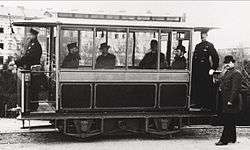
Werner von Siemens demonstrated an electric railway in 1879 in Berlin. The world's first electric tram line, Gross-Lichterfelde Tramway, opened in Lichterfelde near Berlin, Germany, in 1881. It was built by Siemens. The tram ran on 180 Volt DC, which was supplied by running rails. In 1891 the track was equipped with an overhead wire and the line was extended to Berlin-Lichterfelde West station. The Volk's Electric Railway opened in 1883 in Brighton, England. The railway is still operational, thus making it the oldest operational electric railway in the world. Also in 1883, Mödling and Hinterbrühl Tram opened near Vienna in Austria. It was the first tram line in the world in regular service powered from an overhead line. Five years later, in the US electric trolleys were pioneered in 1888 on the Richmond Union Passenger Railway, using equipment designed by Frank J. Sprague.[37]
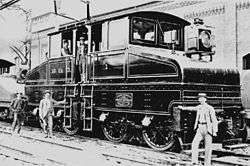
The first use of electrification on a main line was on a four-mile stretch of the Baltimore Belt Line of the Baltimore and Ohio Railroad (B&O) in 1895 connecting the main portion of the B&O to the new line to New York through a series of tunnels around the edges of Baltimore's downtown.
Electricity quickly became the power supply of choice for subways, abetted by the Sprague's invention of multiple-unit train control in 1897. By early 1900s most street railways were electrified.
The first practical AC electric locomotive was designed by Charles Brown, then working for Oerlikon, Zürich. In 1891, Brown had demonstrated long-distance power transmission, using three-phase AC, between a hydro-electric plant at Lauffen am Neckar and Frankfurt am Main West, a distance of 280 km. Using experience he had gained while working for Jean Heilmann on steam-electric locomotive designs, Brown observed that three-phase motors had a higher power-to-weight ratio than DC motors and, because of the absence of a commutator, were simpler to manufacture and maintain.[38] However, they were much larger than the DC motors of the time and could not be mounted in underfloor bogies: they could only be carried within locomotive bodies.[39]
In 1894, Hungarian engineer Kálmán Kandó developed a new type 3-phase asynchronous electric drive motors and generators for electric locomotives. Kandó's early 1894 designs were first applied in a short three-phase AC tramway in Evian-les-Bains (France), which was constructed between 1896 and 1898.[40][41][42][43][44]
In 1896, Oerlikon installed the first commercial example of the system on the Lugano Tramway. Each 30-tonne locomotive had two 110 kW (150 hp) motors run by three-phase 750 V 40 Hz fed from double overhead lines. Three-phase motors run at constant speed and provide regenerative braking, and are well suited to steeply graded routes, and the first main-line three-phase locomotives were supplied by Brown (by then in partnership with Walter Boveri) in 1899 on the 40 km Burgdorf—Thun line, Switzerland.

Italian railways were the first in the world to introduce electric traction for the entire length of a main line rather than just a short stretch. The 106 km Valtellina line was opened on 4 September 1902, designed by Kandó and a team from the Ganz works.[45][46] The electrical system was three-phase at 3 kV 15 Hz. In 1918,[47] Kandó invented and developed the rotary phase converter, enabling electric locomotives to use three-phase motors whilst supplied via a single overhead wire, carrying the simple industrial frequency (50 Hz) single phase AC of the high voltage national networks.[46]
An important contribution to the wider adoption of AC traction came from SNCF of France after World War II. The company conducted trials at 50 Hz, and established it as a standard. Following SNCF's successful trials, 50 Hz (now also called industrial frequency) was adopted as standard for main lines across the world.[48]
Diesel power introduced
Earliest recorded examples of an internal combustion engine for railway use included a prototype designed by William Dent Priestman, which was examined by Sir William Thomson in 1888 who described it as a "[Priestman oil engine] mounted upon a truck which is worked on a temporary line of rails to show the adaptation of a petroleum engine for locomotive purposes.".[49][50] In 1894, a 20 hp (15 kW) two axle machine built by Priestman Brothers was used on the Hull Docks.[51]
In 1906, Rudolf Diesel, Adolf Klose and the steam and diesel engine manufacturer Gebrüder Sulzer founded Diesel-Sulzer-Klose GmbH to manufacture diesel-powered locomotives. Sulzer had been manufacturing diesel engines since 1898. The Prussian State Railways ordered a diesel locomotive from the company in 1909. The world's first diesel-powered locomotive was operated in the summer of 1912 on the Winterthur–Romanshorn railway in Switzerland, but was not a commercial success.[52] The locomotive weight was 95 tonnes and the power was 883 kW with a maximum speed of 100 km/h.[53] Small numbers of prototype diesel locomotives were produced in a number of countries through the mid-1920s.
A significant breakthrough occurred in 1914, when Hermann Lemp, a General Electric electrical engineer, developed and patented a reliable direct current electrical control system (subsequent improvements were also patented by Lemp).[54] Lemp's design used a single lever to control both engine and generator in a coordinated fashion, and was the prototype for all diesel–electric locomotive control systems. In 1914, world's first functional diesel–electric railcars were produced for the Königlich-Sächsische Staatseisenbahnen (Royal Saxon State Railways) by Waggonfabrik Rastatt with electric equipment from Brown, Boveri & Cie and diesel engines from Swiss Sulzer AG. They were classified as DET 1 and DET 2. The first regular use of diesel–electric locomotives was in switching (shunter) applications. General Electric produced several small switching locomotives in the 1930s (the famous "44-tonner" switcher was introduced in 1940) Westinghouse Electric and Baldwin collaborated to build switching locomotives starting in 1929.
In 1929, the Canadian National Railways became the first North American railway to use diesels in mainline service with two units, 9000 and 9001, from Westinghouse.[55]
High-speed rail
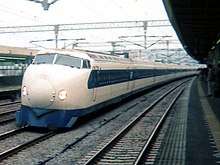
The first electrified high-speed rail Tōkaidō Shinkansen (series 0) was introduced in 1964 between Tokyo and Osaka in Japan. Since then high-speed rail transport, functioning at speeds up and above 300 km/h, has been built in Japan, Spain, France, Germany, Italy, Taiwan(Republic of China) ,the People's Republic of China, the United Kingdom, South Korea, Scandinavia, Belgium and the Netherlands. The construction of many of these lines has resulted in the dramatic decline of short haul flights and automotive traffic between connected cities, such as the London–Paris–Brussels corridor, Madrid–Barcelona, Milan–Rome–Naples, as well as many other major lines.
High-speed trains normally operate on standard gauge tracks of continuously welded rail on grade-separated right-of-way that incorporates a large turning radius in its design. While high-speed rail is most often designed for passenger travel, some high-speed systems also offer freight service.
Hydrogen power introduced
Alstom Coradia Lint hydrogen-powered train entered service in Lower Saxony, Germany in 2018.
History by country
Europe
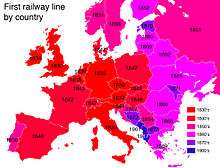
Belgium
Belgium took the lead in the Industrial Revolution on the Continent starting in the 1820s. It provided an ideal model for showing the value of the railways for speeding the industrial revolution. After splitting from the Netherlands in 1830, the new country decided to stimulate industry. It planned and funded a simple cross-shaped system that connected the major cities, ports and mining areas and linked to neighboring countries. Unusually, the Belgian state became a major contributor to early rail development and championed the creation of a national network with no duplication of lines. Belgium thus became the railway center of the region.
The system was built along British lines, often with British engineers doing the planning. Profits were low but the infrastructure necessary for rapid industrial growth was put in place.[56] The first railway in Belgium, running from northern Brussels to Mechelen, was completed in May 1835.
Britain
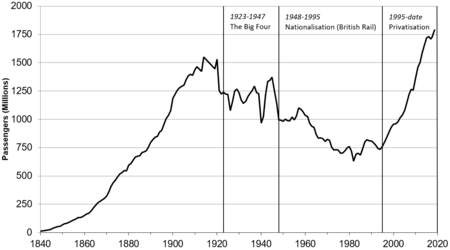
Early developments
The earliest railway in Britain was a wagonway system, a horse drawn wooden rail system, used by German miners at Caldbeck, Cumbria, England, perhaps from the 1560s.[13] A wagonway was built at Prescot, near Liverpool, sometime around 1600, possibly as early as 1594. Owned by Philip Layton, the line carried coal from a pit near Prescot Hall to a terminus about half a mile away.[14] On 26 July 1803, Jessop opened the Surrey Iron Railway, south of London erroneously considered first railway in Britain, also a horse-drawn one. It was not a railway in the modern sense of the word, as it functioned like a turnpike road. There were no official services, as anyone could bring a vehicle on the railway by paying a toll.
The Middleton Railway in Leeds, which was built in 1758, later became the world's oldest operational railway (other than funiculars), albeit now in an upgraded form. In 1764, the first railway in the Americas was built in Lewiston, New York.[17] The first passenger Horsecar or tram, Swansea and Mumbles Railway was opened between Swansea and Mumbles in Wales in 1807.[57] Horse remained preferable mode for tram transport even after arrival of steam engines, well till the end of 19th century. The major reason was that the horse-cars were clean as compared to steam driven trams which caused smoke in city streets.
In 1812, Oliver Evans, an American engineer and inventor, published his vision of what steam railways could become, with cities and towns linked by a network of long distance railways plied by speedy locomotives, greatly speeding up personal travel and goods transport. Evans specified that there should be separate sets of parallel tracks for trains going in different directions. However, conditions in the infant United States did not enable his vision to take hold. This vision had its counterpart in Britain, where it proved to be far more influential. William James, a rich and influential surveyor and land agent, was inspired by the development of the steam locomotive to suggest a national network of railways. It seems likely[58] that in 1808 James attended the demonstration running of Richard Trevithick's steam locomotive Catch me who can in London; certainly at this time he began to consider the long-term development of this means of transport. He proposed a number of projects that later came to fruition and is credited with carrying out a survey of the Liverpool and Manchester Railway. Unfortunately he became bankrupt and his schemes were taken over by George Stephenson and others. However, he is credited by many historians with the title of "Father of the Railway".[58]
It was not until 1825, that the success of the Stockton and Darlington Railway, world's first public railway, proved that the railways could be made as useful to the general shipping public as to the colliery owner. This railway broke new ground by using rails made of rolled wrought iron, produced at Bedlington Ironworks in Northumberland.[59] Such rails were stronger. This railway linked the town of Darlington with the port of Stockton-on-Tees and was intended to enable local collieries (which were connected to the line by short branches) to transport their coal to the docks. As this would constitute the bulk of the traffic, the company took the important step of offering to haul the colliery wagons or chaldrons by locomotive power, something that required a scheduled or timetabled service of trains. However, the line also functioned as a toll railway, on which private horse-drawn wagons could be carried. This curious hybrid of a system (which also included, at one stage, a horse-drawn passenger wagon) could not last and within a few years, traffic was restricted to timetabled trains. (However, the tradition of private owned wagons continued on railways in Britain until the 1960s.)
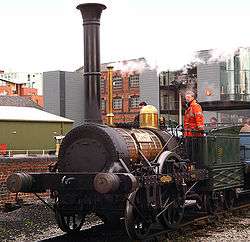
The success of the Stockton and Darlington encouraged the rich investors in the rapidly industrialising North West of England to embark upon a project to link the rich cotton manufacturing town of Manchester with the thriving port of Liverpool. The Liverpool and Manchester Railway was the first modern railway, in that both the goods and passenger traffic were operated by scheduled or timetabled locomotive hauled trains. When it was built, there was serious doubt that locomotives could maintain a regular service over the distance involved. A widely reported competition was held in 1829 called the Rainhill Trials, to find the most suitable steam engine to haul the trains. A number of locomotives were entered, including Novelty, Perseverance and Sans Pareil. The winner was Stephenson's Rocket, which steamed better because of its multi-tubular boiler (suggested by Henry Booth, a director of the railway company).
The promoters were mainly interested in goods traffic, but after the line opened on 15 September 1830, they were surprised to find that passenger traffic was just as remunerative. The success of the Liverpool and Manchester railway influenced the development of railways elsewhere in Britain and abroad. The company hosted many visiting deputations from other railway projects and many railwaymen received their early training and experience upon this line. The Liverpool and Manchester line was, however, only 35 miles (56 km) long. The world's first trunk line can be said to be the Grand Junction Railway, opening in 1837 and linking a midpoint on the Liverpool and Manchester Railway with Birmingham, via Crewe, Stafford and Wolverhampton.
Further development
The earliest locomotives in revenue service were small four-wheeled ones similar to the Rocket. However, the inclined cylinders caused the engine to rock, so they first became horizontal and then, in his "Planet" design, were mounted inside the frames. While this improved stability, the "crank axles" were extremely prone to breakage. Greater speed was achieved by larger driving wheels at expense of a tendency for wheel slip when starting. Greater tractive effort was obtained by smaller wheels coupled together, but speed was limited by the fragility of the cast iron connecting rods. Hence, from the beginning, there was a distinction between the light fast passenger locomotive and the slower more powerful goods engine. Edward Bury, in particular, refined this design and the so-called "Bury Pattern" was popular for a number of years, particularly on the London and Birmingham.
Meanwhile, by 1840, Stephenson had produced larger, more stable, engines in the form of the 2-2-2 "Patentee" and six-coupled goods engines. Locomotives were travelling longer distances and being worked more extensively. The North Midland Railway expressed their concern to Robert Stephenson who was, at that time, their general manager, about the effect of heat on their fireboxes. After some experiments, he patented his so-called Long Boiler design. These became a new standard and similar designs were produced by other manufacturers, particularly Sharp Brothers whose engines became known affectionately as "Sharpies".
The longer wheelbase for the longer boiler produced problems in cornering. For his six-coupled engines, Stephenson removed the flanges from the centre pair of wheels. For his express engines, he shifted the trailing wheel to the front in the 4-2-0 formation, as in his "Great A". There were other problems: the firebox was restricted in size or had to be mounted behind the wheels; and for improved stability most engineers believed that the centre of gravity should be kept low.
The most extreme outcome of this was the Crampton locomotive which mounted the driving wheels behind the firebox and could be made very large in diameter. These achieved the hitherto unheard of speed of 70 mph (110 km/h) but were very prone to wheelslip. With their long wheelbase, they were unsuccessful on Britain's winding tracks, but became popular in the US and France, where the popular expression became prendre le Crampton.
John Gray of the London and Brighton Railway disbelieved the necessity for a low centre of gravity and produced a series of locomotives that were much admired by David Joy who developed the design at the firm of E. B. Wilson and Company to produce the 2-2-2 Jenny Lind locomotive, one of the most successful passenger locomotives of its day. Meanwhile, the Stephenson 0-6-0 Long Boiler locomotive with inside cylinders became the archetypal goods engine.
| Year | Total miles |
|---|---|
| 1830 | 98 |
| 1835 | 338 |
| 1840 | 1,498 |
| 1845 | 2,441 |
| 1850 | 6,621 |
| 1855 | 8,280 |
| 1860 | 10,433 |
Expanding network
Railways quickly became essential to the swift movement of goods and labour that was needed for industrialization. In the beginning, canals were in competition with the railways, but the railways quickly gained ground as steam and rail technology improved and railways were built in places where canals were not practical.
By the 1850s, many steam-powered railways had reached the fringes of built-up London. But the new companies were not permitted to demolish enough property to penetrate the City or the West End, so passengers had to disembark at Paddington, Euston, King's Cross, Fenchurch Street, Charing Cross, Waterloo or Victoria and then make their own way by hackney carriage or on foot into the centre, thereby massively increasing congestion in the city. A Metropolitan Railway was built underground to connect several of these separate railway terminals and was the world's first "Metro".
Social and economic consequences
The railways changed British society in numerous and complex ways. Although recent attempts to measure the economic significance of the railways have suggested that their overall contribution to the growth of GDP was more modest than an earlier generation of historians sometimes assumed, it is nonetheless clear that the railways had a sizeable impact in many spheres of economic activity. The building of railways and locomotives, for example, called for large quantities of heavy materials and thus provided a significant stimulus or 'backward linkage', to the coal-mining, iron-production, engineering and construction industries.
They also helped to reduce transaction costs, which in turn lowered the costs of goods: the distribution and sale of perishable goods such as meat, milk, fish and vegetables were transformed by the emergence of the railways, giving rise not only to cheaper produce in the shops but also to far greater variety in people's diets.
Finally, by improving personal mobility the railways were a significant force for social change. Rail transport had originally been conceived as a way of moving coal and industrial goods but the railway operators quickly realised the potential market for railway travel, leading to an extremely rapid expansion in passenger services. The number of railway passengers trebled in just eight years between 1842 and 1850: traffic volumes roughly doubled in the 1850s and then doubled again in the 1860s.[61]
As the historian Derek Aldcroft has noted, 'in terms of mobility and choice they added a new dimension to everyday life'.[62]
Bulgaria
The Ruse – Varna was the first railway line in the modern Bulgarian territory, and also in the former Ottoman Empire. It was started in 1864 by the Turkish government, by commissioning for it an English company managed by William Gladstone, a politician, and the Barkley brothers, civil engineers. The line, which was 223 km long, was opened in 1866.
France
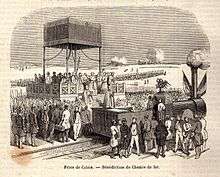
In France, railways were first operated by private coal companies the first legal agreement to build a railway was given in 1823 and the line (from Saint-Étienne to Andrézieux) was operated in 1827. Much of the equipment was imported from Britain but this stimulated machinery makers, which soon created a national heavy industry. Trains became a national medium for the modernization of backward regions and a leading advocate of this approach was the poet-politician Alphonse de Lamartine. One writer hoped that railways might improve the lot of "populations two or three centuries behind their fellows" and eliminate "the savage instincts born of isolation and misery." Consequently, France built a centralized system that radiated from Paris (plus lines that cut east to west in the south). This design was intended to achieve political and cultural goals rather than maximize efficiency.
After some consolidation, six companies controlled monopolies of their regions, subject to close control by the government in terms of fares, finances and even minute technical details. The central government department of Ponts et Chaussées [bridges and roads] brought in British engineers and workers, handled much of the construction work, provided engineering expertise and planning, land acquisition and construction of permanent infrastructure such as the track bed, bridges and tunnels. It also subsidized militarily necessary lines along the German border, which was considered necessary for the national defense. Private operating companies provided management, hired labor, laid the tracks and built and operated stations. They purchased and maintained the rolling stock—6,000 locomotives were in operation in 1880, which averaged 51,600 passengers a year or 21,200 tons of freight.
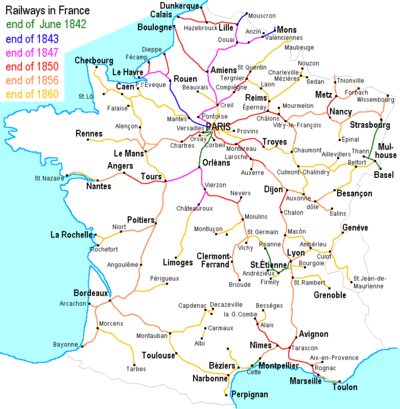
Although starting the whole system at once was politically expedient, it delayed completion and forced even more reliance on temporary experts brought in from Britain. Financing was also a problem. The solution was a narrow base of funding through the Rothschilds and the closed circles of the Bourse in Paris, so France did not develop the same kind of national stock exchange that flourished in London and New York. The system did help modernize the parts of rural France it reached and help to develop many local industrial centers, mostly in the North (coal and iron mines) and in the East (textiles and heavy industry). Critics such as Émile Zola complained that it never overcame the corruption of the political system, but rather contributed to it.
The railways probably helped the industrial revolution in France by facilitating a national market for raw materials, wines, cheeses and imported and exported manufactured products. In The Rise of Rail-Power in War and Conquest, 1833–1914, published in 1915, Edwin A. Pratt wrote, "the French railways … attained a remarkable degree of success. … It was estimated that the 75,966 men and 4,469 horses transported by rail from Paris to the Mediterranean or to the frontiers of the Kingdom of Sardinia between 20 and 30 April April [during the 1859 Second Italian War of Independence] would have taken sixty days to make the journey by road. … This… was about twice as fast as the best achievement recorded up to that time on the German railways.[63] " Yet the goals set by the French for their railway system were moralistic, political and military rather than economic. As a result, the freight trains were shorter and less heavily loaded than those in such rapidly industrializing nations such as Britain, Belgium or Germany. Other infrastructure needs in rural France, such as better roads and canals, were neglected because of the expense of the railways, so it seems likely that there were net negative effects in areas not served by the trains.[64]
Germany
An operation was illustrated in Germany in 1556 by Georgius Agricola in his work De re metallica.[10] This line used "Hund" carts with unflanged wheels running on wooden planks and a vertical pin on the truck fitting into the gap between the planks to keep it going the right way. The miners called the wagons Hunde ("dogs") from the noise they made on the tracks.[11] This system became very popular across Europe.
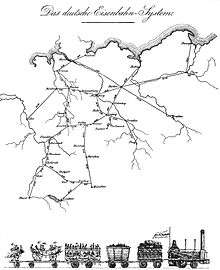
The takeoff stage of economic development came with the railroad revolution in the 1840s, which opened up new markets for local products, created a pool of middle managers, increased the demand for engineers, architects and skilled machinists and stimulated investments in coal and iron.[65] Political disunity of three dozen states and a pervasive conservatism made it difficult to build railways in the 1830s. However, by the 1840s, trunk lines did link the major cities; each German state was responsible for the lines within its own borders. Economist Friedrich List summed up the advantages to be derived from the development of the railway system in 1841:
- As a means of national defence, it facilitates the concentration, distribution and direction of the army.
- It is a means to the improvement of the culture of the nation. It brings talent, knowledge and skill of every kind readily to market.
- It secures the community against dearth and famine and against excessive fluctuation in the prices of the necessaries of life.
- It promotes the spirit of the nation, as it has a tendency to destroy the Philistine spirit arising from isolation and provincial prejudice and vanity. It binds nations by ligaments and promotes an interchange of food and of commodities, thus making it feel to be a unit. The iron rails become a nerve system, which, on the one hand, strengthens public opinion, and, on the other hand, strengthens the power of the state for police and governmental purposes.[66]
Lacking a technological base at first, the Germans imported their engineering and hardware from Britain, but quickly learned the skills needed to operate and expand the railways. In many cities, the new railway shops were the centres of technological awareness and training, so that by 1850, Germany was self-sufficient in meeting the demands of railroad construction and the railways were a major impetus for the growth of the new steel industry. Observers found that even as late as 1890, their engineering was inferior to Britain's. However, German unification in 1870 stimulated consolidation, nationalisation into state-owned companies and further rapid growth. Unlike the situation in France, the goal was support of industrialisation and so heavy lines crisscrossed the Ruhr and other industrial districts and provided good connections to the major ports of Hamburg and Bremen. By 1880, Germany had 9,400 locomotives pulling 43,000 passengers and 30,000 tons of freight a day and forged ahead of France.[67]
Italy
Netherlands
Rail transport in the Netherlands is generally considered to have begun on 20 September 1839 when the first train, drawn by the locomotive De Arend, successfully made the 16 km trip from Amsterdam to Haarlem. However, the first plan for a railroad in the Netherlands was launched only shortly after the first railroad opened in Britain.
The history of rail transport in the Netherlands can be described in six eras:
- the period up to 1839 – the first plans were made for a railroad,
- 1840–1860 – railroads experienced their early expansion,
- 1860–1890 – the government started ordering the construction of new lines,
- 1890–1938 – the different railroads were consolidated into two large railroads,
- 1938–1992 – Nederlandse Spoorwegen was granted a monopoly on rail transport, and
- 1992 to present – the Nederlandse Spoorwegen lost its monopoly.
Poland
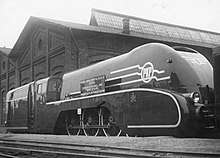
Poland restored its own independence as the Second Polish Republic in 1918 from the German, Austro-Hungarian and Russian Empires. First Polish locomotive Ok22 (100 km/h) started operating in 1923. Imported electric locomotives English Electric EL.100 (100 km/h) were in use in Warsaw since 1936. New Polish locomotive Pm36-1 (140 km/h) was shown at the International Exposition of Art and Technology in Modern Life in Paris in 1937. New Polish electric locomotive EP09 (160 km/h) was designed in 1977 and started regular operation linking Warsaw and Kraków in 1987. On 14 December 2014 PKP Intercity New Pendolino trains by Alstom under the name 'Express Intercity Premium' began operating on the CMK line (224 km line from Kraków and Katowice to Warsaw) with trains reaching 200 km/h (124 mph) as a regularly scheduled operation.
Russia
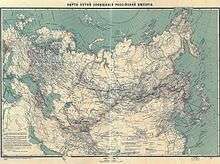
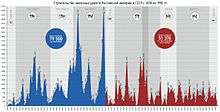
In the early 1830s, the Russian father and son inventors the Cherepanovs built the first Russian steam locomotive. The first railway line was built in Russia in 1837 between Saint-Petersburg and Tsarskoye Selo. It was 27 km long and linked the Imperial Palaces at Tsarskoye Selo and Pavlovsk. The track gauge was 6 feet (1.8 metres). Russia was in need of big transportation systems and geographically suited to railroads, with long flat stretches of land and comparatively simple land acquisition. It was hampered, however, by its outmoded political situation and a shortage of capital. Foreign initiative and capital were required. It was the Americans who brought the technology of railway construction to Russia. In 1842, planning began for the building of Russia's first important railway; it linked Moscow and St Petersburg.[68]
Spain
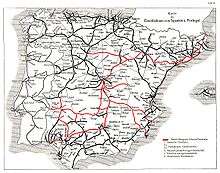
Cuba, then a Spanish colony, built its first rail line in 1837. The history of rail transport in peninsular Spain begins in 1848 with the construction of a railway line between Barcelona and Mataró. In 1852, the first narrow gauge line was built. In 1863 a line reached the Portuguese border. By 1864, the Madrid-Irun line had been opened and the French border was reached.
Northern America
Canada
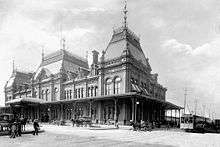
The first Canadian railway, the Champlain and St. Lawrence Railroad, was opened in 1836 outside of Montreal, a seasonal portage railway to connect river traffic. It was followed by the Albion Railway in Stellarton, Nova Scotia in 1840, a collier railway connecting coal mines to a seaport. In Canada, the national government strongly supported railway construction for political goals. First it wanted to knit the far-flung provinces together and second, it wanted to maximize trade inside Canada and minimize trade with the United States, to avoid becoming an economic satellite. The Grand Trunk Railway of Canada linked Toronto and Montreal in 1853, then opened a line to Portland, Maine (which was ice-free) and lines to Michigan and Chicago. By 1870 it was the longest railway in the world. The Intercolonial line, finished in 1876, linked the Maritimes to Quebec and Ontario, tying them to the new Confederation.
Anglo entrepreneurs in Montreal sought direct lines into the US and shunned connections with the Maritimes, with a goal of competing with American railroad lines heading west to the Pacific. Joseph Howe, Charles Tupper and other Nova Scotia leaders used the rhetoric of a "civilizing mission" centered on their British heritage, because Atlantic-centered railway projects promised to make Halifax the eastern terminus of an intercolonial railway system tied to London. Leonard Tilley, New Brunswick's most ardent railway promoter, championed the cause of "economic progress," stressing that Atlantic Canadians needed to pursue the most cost-effective transportation connections possible if they wanted to expand their influence beyond local markets. Advocating an intercolonial connection to Canada and a western extension into larger American markets in Maine and beyond, New Brunswick entrepreneurs promoted ties to the United States first, connections with Halifax second and routes into central Canada last. Thus metropolitan rivalries between Montreal, Halifax and Saint John led Canada to build more railway lines per capita than any other industrializing nation, even though it lacked capital resources and had too little freight and passenger traffic to allow the systems to turn a profit.[69]
Den Otter (1997) challenges popular assumptions that Canada built transcontinental railways because it feared the annexationist schemes of aggressive Americans. Instead Canada overbuilt railroads because it hoped to compete with, even overtake Americans in the race for continental riches. It downplayed the more realistic Maritimes-based London-oriented connections and turned to utopian prospects for the farmlands and minerals of the west. The result was closer ties between north and south, symbolized by the Grand Trunk's expansion into the American Midwest. These economic links promoted trade, commerce and the flow of ideas between the two countries, integrating Canada into a North American economy and culture by 1880. About 700,000 Canadians migrated to the US in the late 19th century.[70] The Canadian Pacific, paralleling the American border, opened a vital link to British Canada and stimulated settlement of the Prairies. The CP was affiliated with James J. Hill's American railways and opened even more connections to the South. The connections were two-way, as thousands of American moved to the Prairies after their own frontier had closed.
Two additional transcontinental lines were built to the west coast—three in all—but that was far more than the traffic would bear, making the system simply too expensive. One after another, the federal government was forced to take over the lines and cover their deficits. In 1923, the government merged the Grand Trunk, Grand Trunk Pacific, Canadian Northern and National Transcontinental lines into the new the Canadian National Railways system. Since most of the equipment was imported from Britain or the US and most of the products carried were from farms, mines or forests, there was little stimulation to domestic manufacturing. On the other hand, the railways were essential to the growth of the wheat regions in the Prairies and to the expansion of coal mining, lumbering and paper making. Improvements to the St. Lawrence waterway system continued apace and many short lines were built to river ports.[71]
United States
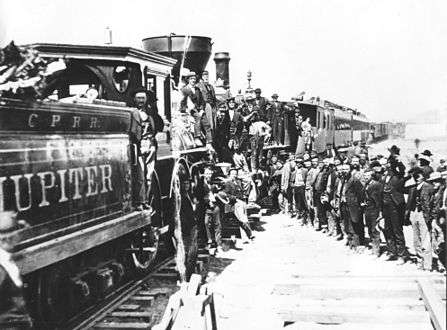
Overview
The earliest railway in Canada is a wooden railroad reportedly used in the construction of the French fortress at Louisburg, Nova Scotia.[72]
Railroads played a large role in the development of the United States from the industrial revolution in the North-east 1810–50 to the settlement of the West 1850–1890. The American railroad mania began with the Baltimore and Ohio Railroad in 1828 and flourished until the Panic of 1873 bankrupted many companies and temporarily ended growth.
Although the South started early to build railways, it concentrated on short lines linking cotton regions to oceanic or river ports and the absence of an interconnected network was a major handicap during the Civil War. The North and Midwest constructed networks that linked every city by 1860. In the heavily settled Midwestern Corn Belt, over 80 percent of farms were within 10 miles of a railway, facilitating the shipment of grain, hogs and cattle to national and international markets. A large number of short lines were built, but thanks to a fast developing financial system based on Wall Street and oriented to railway bonds, the majority were consolidated into 20 trunk lines by 1890. State and local governments often subsidized lines, but rarely owned them.
The system was largely built by 1910, but then trucks arrived to eat away the freight traffic and automobiles (and later airplanes) to devour the passenger traffic. The use of diesel electric locomotives (after 1940) made for much more efficient operations that needed fewer workers on the road and in repair shops.
Mileage
Route mileage peaked at 254,000 in 1916 and fell to 140,000 in 2009.[73]
In 1830, there were about 75 miles (121 km) of railroad track, in short lines linked to coal and granite mines.[74]). After this, railroad lines grew rapidly. Ten years later, in 1840, the railways had grown to 2,800 miles (4,500 km). By 1860, on the eve of civil war, the length had reached 29,000 miles (47,000 km), mostly in the North. The South had much less trackage and it was geared to moving cotton short distances to river or ocean ports. The Southern railroads were destroyed during the war but were soon rebuilt. By 1890, the national system was virtually complete with 164,000 miles (264,000 km).[75]
| Railroad Accumulated Mileage by Region | |||||||
|---|---|---|---|---|---|---|---|
| 1830 | 1840 | 1850 | 1860 | 1870 | 1880 | 1890 | |
| ME, NH, VT, MA, RI, CT | 29.80 | 513.34 | 2,595.57 | 3,644.24 | 4,326.73 | 5,888.09 | 6,718.19 |
| NY, PA, OH, MI, IN, MD, DE, NJ, DC | 1,483.76 | 3,740.36 | 11,927.21 | 18,291.93 | 28,154.73 | 40,825.60 | |
| VA, WV, KY, TN, MS, AL, GA, FL, NC, SC | 10.00 | 737.33 | 2,082.07 | 7,907.79 | 10,609.60 | 14,458.33 | 27,833.15 |
| IL, IA, WI, MO, MN |
46.48 | 4,951.47 | 11,030.85 | 22,212.98 | 35,579.80 | ||
| LA, AR & OK (Indian) Territory |
20.75 |
107.00 | 250.23 | 331.23 | 1,621.11 | 5,153.91 | |
| (Terr.)ND/SD, NM, WY, MT, ID, UT, AZ, WA (States)NE, KS, TX, CO, CA, NV, OR |
238.85 | 4,577.99 | 15,466.18 | 47,451.47 | |||
| TOTAL USA | 39.80 | 2,755.18 | 8,571.48 | 28,919.79 | 49,168.33 | 87,801.42 | 163,562.12 |
In 1869, the symbolically important transcontinental railroad was completed in the United States with the driving of a golden spike (near the city of Ogden).
Latin America

In Latin America in the late 19th and early 20th centuries railways were critical elements in the early stages of modernization of the Latin American economy, especially in linking agricultural regions to export-oriented seaports.[77] After 1870 Latin American governments encouraged further rail development through generous concessions that included government subsidies for construction. Railway construction is the subject of considerable scholarship, examining the economic, political, and social impacts of railroads. Railways transformed many regions of Latin America beginning in the late nineteenth century. "Increasing exports of primary commodities, rising imports of capital goods, the expansion of activities drawing directly and indirectly on overseas investment, the rising share of manufacturing in output, and a generalized increase in the pace and scope of economic activity were all tied closely to the timing and character of the region's infrastructural development.[78]
Rates of railway line construction were not uniform, but by 1870 railway line construction was underway, with Cuba leading with the largest railway track in service (1,295 km), followed by Chile (797 km), Brazil (744 km), Argentina (732 km), Peru (669 km), and Mexico (417 km). By 1900, Argentina (16,563 km), Brazil (15,316 km) and Mexico (13,615 km) were the leaders in length of track in service, and Peru, which had been an early leader in railway construction, had stagnated (1,790 km).[79] In Mexico, growing nationalistic fervor led the government to bring the bulk of the nation's railroads under national control in 1909, with a new government corporation, Ferrocarriles Nacionales de México (FNM), that exercised control of the main trunk rail lines through a majority of share ownership.[80]
Asia
India
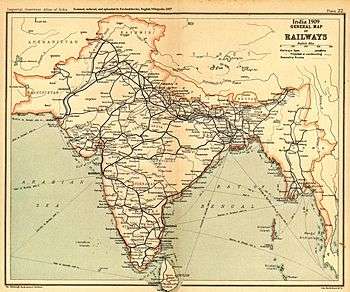
The first proposals for railways in India were made in Madras in 1832.[81] The first train in India ran from Red Hills to Chintadripet bridge in Madras in 1837. It was called Red Hill Railway. It was hauled by a rotary steam engine locomotive manufactured by William Avery. It was built by Sir Arthur Cotton. It was primarily used for transporting granite stones for road building work in Madras.[81] In 1845, a railway was built at Dowleswaram in Rajahmundry. It was called Godavari Dam Construction Railway. It was also built by Arthur Cotton. It was used to supply stones for construction of a dam over Godavari.[81]
On 8 May 1845, Madras Railway was incorporated. In the same year, the East India Railway company was incorporated. On 1 August 1849, Great Indian Peninsular Railway (GIPR) was incorporated. In 1851, a railway was built in Roorkee. It was called Solani Aqueduct Railway. It was hauled by steam locomotive Thomason, named after a British officer-in-charge. It was used for transporting construction materials for building of aqueduct over Solani river.[81] In 1852, the "Madras Guaranteed Railway Company" was incorporated.
The first passenger train in India ran between Bombay (Bori Bunder) and Thane on 16 April 1853. The 14-carriage train was hauled by three steam locomotives: Sahib, Sindh and Sultan. It ran for about 34 kilometers between these two cities carrying 400 people. The line was built and operated by GIPR.[82][83] This railway line was built in 1,676 mm (5 ft 6 in) broad gauge, which became the standard for the railways in the country. The first passenger railway train in eastern India ran from Howrah, near Calcutta to Hoogly, for distance of 24 miles, on 15 August 1854. The line was built and operated by EIR.[84] The first passenger train in South India ran from Royapuram / Veyasarapady (Madras) to Wallajah Road (Arcot) on 1 July 1856, for a distance of 60 miles. It was built and operated by Madras Railway.[85] On 24 February 1873, the first tramway (a horse-drawn tramway) opened in Calcutta between Sealdah and Armenian Ghat Street, a distance of 3.8 km.[86]
Iran
Iranian railway history goes back to 1887 when an approximately 20-km long railway between Tehran and Ray was established. After this time many short railways were constructed but the main railway, Trans-Iranian Railway, was started in 1927 and operated in 1938 by connecting the Persian Gulf to the Caspian Sea.
Japan
Japan developed its first railway line in 1872 with technical and materiel assistance provided by several western nations such as Britain and America.
Pakistan
It was in 1847 when the first railway was imagined but it was not until 1861 when it came into existence in the form of the railway built from Karachi to Kotri. Since then rail transport is a popular mode of non-independent transport in Pakistan.[87]
Africa
Angola
Botswana
Congo
East Africa
The railway was built from the Kenyan port of Mombasa to Kampala, Uganda, and construction was hampered by the presence of man-eating lions.[88]
Egypt
1833–1877
Robert Stephenson (1803–59) was the engineer of Egypt's first railway
In 1833, Muhammad Ali Pasha considered building a railway between Suez and Cairo to improve transit between Europe and India. Muhammad Ali had proceeded to buy the rail when the project was abandoned due to pressure by the French who had an interest in building a canal instead.[citation needed]
Proposed railway from Cairo to the Sea of Suez by C.F. Cheffins, 1840s; state carriage by Wason Manufacturing built for Sa'id Pasha for state functions, included with 161 less ornate railcars sent by the company in 1860
Muhammad Ali died in 1848, and in 1851 his successor Abbas I contracted Robert Stephenson to build Egypt's first standard gauge railway. The first section, between Alexandria on the Mediterranean coast and Kafr el-Zayyat on the Rosetta branch of the Nile was opened in 1854. This was the first railway in the Ottoman Empire as well as Africa and the Middle East. In the same year Abbas died and was succeeded by Sa'id Pasha, in whose reign the section between Kafr el-Zayyat and Cairo was completed in 1856 followed by an extension from Cairo to Suez in 1858. This completed the first modern transport link between the Mediterranean and the Indian Ocean, as Ferdinand de Lesseps did not complete the Suez Canal until 1869.
Namibia (South West Africa)
The first railway in the German colony of South West Africa was the 18 kilometres (11 mi)-long line running North-East from Walvis Bay to connect with the existing road between Swakopmund and Windhoek. It was built to 2 ft 6 in (762 mm) gauge and was opened in 1898.[89]
Morocco
The Moroccan rail transport was first developed around 1906 and later during the French and Spanish protectorate. It functioned initially as a means to transport natural resources from in-land mines to the harbors. It was also used to move colonial troops.
Mozambique
South Africa
Sudan
Zambia
Zimbabwe
See also
- Category:Rail transport timelines
- George Bradshaw, originator of the railway timetable
- Historical sizes of railroads in North America
- John Blenkinsop (1783–1831), inventor
- Matthias W. Baldwin (1795–1866), manufacturer
- Oldest railroads in North America
- Permanent way: historical development
- Railway speed record
- Railway spine
- Thomas Gray (1788–1848), railway advocate, published 1st ed. of Observations on a General Iron Railway, 1820.
- Timeline of railway history
- History of trams
References
- Verdelis, Nikolaos: "Le diolkos de L'Isthme", Bulletin de Correspondance Hellénique, vol. 81 (1957), pp. 526–529 (526)
- Cook, R. M.: "Archaic Greek Trade: Three Conjectures 1. The Diolkos", The Journal of Hellenic Studies, vol. 99 (1979), pp. 152–155 (152)
- Drijvers, J.W.: "Strabo VIII 2,1 (C335): Porthmeia and the Diolkos", Mnemosyne, vol. 45 (1992), pp. 75–76 (75)
- Raepsaet, G. & Tolley, M.: "Le Diolkos de l’Isthme à Corinthe: son tracé, son fonctionnement", Bulletin de Correspondance Hellénique, vol. 117 (1993), pp. 233–261 (256)
- Lewis, M. J. T., "Railways in the Greek and Roman world" Archived 21 July 2011 at the Wayback Machine, in Guy, A. / Rees, J. (eds), Early Railways. A Selection of Papers from the First International Early Railways Conference (2001), pp. 8–19 (11)
- Fraser 1961, pp. 134 & 137
- Fraser 1961, p. 134f.
- "Der Reiszug: Part 1 – Presentation". Funimag. Retrieved 22 April 2009.
- Kriechbaum, Reinhard (15 May 2004). "Die große Reise auf den Berg". der Tagespost (in German). Archived from the original on 28 June 2012. Retrieved 22 April 2009.
- Georgius Agricola (trans Hoover), De re metallica (1913), p. 156.
- Lee, Charles E. (1943). The Evolution of Railways. Railway Gazette (2 ed.). London. p. 16. OCLC 1591369.
- Lewis, Early wooden railways, pp. 8–10.
- Warren Allison, Samuel Murphy and Richard Smith, An Early Railway in the German Mines of Caldbeck in G. Boyes (ed.), Early Railways 4: Papers from the 4th International Early Railways Conference 2008 (Six Martlets, Sudbury, 2010), pp. 52–69.
- Jones, Mark (2012). Lancashire Railways – The History of Steam. Newbury: Countryside Books. p. 5. ISBN 978-1-84674-298-9.
- Peter King, The First Shropshire Railways in G. Boyes (ed.), Early Railways 4: Papers from the 4th International Early Railways Conference 2008 (Six Martlets, Sudbury, 2010), pp. 70–84.
- "Huntingdon Beaumont's Wollaton to Strelley Waggonway". Nottingham Hidden History. 30 July 2013. Retrieved 23 August 2017.
- Porter, Peter (1914). Landmarks of the Niagara Frontier. The Author. ISBN 0-665-78347-7.
- Tylecote, R. F. (1992). A History of Metallurgy, Second Edition. London: Maney Publishing, for the Institute of Materials. ISBN 978-0901462886.
- Vaughan, A. (1997). Railwaymen, Politics and Money. London: John Murray. ISBN 0-7195-5746-1.
- "Surrey Iron Railway 200th – 26th July 2003". Early Railways. Stephenson Locomotive Society. Archived from the original on 12 May 2009.
- Landes, David. S. (1969). The Unbound Prometheus: Technological Change and Industrial Development in Western Europe from 1750 to the Present. Cambridge, New York: Press Syndicate of the University of Cambridge. p. 91. ISBN 0-521-09418-6.CS1 maint: ref=harv (link)
- Landes 1969, p. 92
- Wells, David A. (1891). Recent Economic Changes and Their Effect on Production and Distribution of Wealth and Well-Being of Society. New York: D. Appleton and Co. ISBN 0-543-72474-3.
- Grübler, Arnulf (1990). The Rise and Fall of Infrastructures: Dynamics of Evolution and Technological Change in Transport (PDF). Heidelberg and New York: Physica-Verlag.
- Fogel, Robert W. (1964). Railroads and American Economic Growth: Essays in Econometric History. Baltimore and London: The Johns Hopkins Press. ISBN 0-8018-1148-1.
- Rosenberg, Nathan (1982). Inside the Black Box: Technology and Economics. Cambridge, New York: Cambridge University Press. p. 60. ISBN 0-521-27367-6.
- Gordon, W.J. (1910). Our Home Railways, volume one. London: Frederick Warne and Co. pp. 7–9.
- "Richard Trevithick's steam locomotive". National Museum Wales. Archived from the original on 15 April 2011. Retrieved 3 October 2009.
- "Steam train anniversary begins". BBC. 21 February 2004. Retrieved 13 June 2009.
A south Wales town has begun months of celebrations to mark the 200th anniversary of the invention of the steam locomotive. Merthyr Tydfil was the location where, on 21 February 1804, Richard Trevithick took the world into the railway age when he set one of his high-pressure steam engines on a local iron master's tram rails
- Hamilton Ellis (1968). The Pictorial Encyclopedia of Railways. The Hamlyn Publishing Group. p. 12.
- Hamilton Ellis (1968). The Pictorial Encyclopedia of Railways. The Hamlyn Publishing Group. pp. 20–22.
- Ellis, Hamilton (1968). The Pictorial Encyclopedia of Railways. Hamlyn Publishing Group.
- Hamilton Ellis (1968). The Pictorial Encyclopedia of Railways. The Hamlyn Publishing Group. pp. 24–30.
- Day, Lance; McNeil, Ian (1966). "Davidson, Robert". Biographical dictionary of the history of technology. London: Routledge. ISBN 978-0-415-06042-4.
- Gordon, William (1910). "The Underground Electric". Our Home Railways. 2. London: Frederick Warne and Co. p. 156.
- Renzo Pocaterra, Treni, De Agostini, 2003
- "Richmond Union Passenger Railway". IEEE History Center. Retrieved 18 January 2008.
- Heilmann evaluated both AC and DC electric transmission for his locomotives, but eventually settled on a design based on Thomas Edison's DC system – Duffy (2003), pp. 39–41
- Duffy (2003), p. 129.
- Andrew L. Simon (1998). Made in Hungary: Hungarian Contributions to Universal Culture. Simon Publications LLC. p. 264. ISBN 978-0-9665734-2-8.
- Francis S. Wagner (1977). Hungarian Contributions to World Civilization. Alpha Publications. p. 67. ISBN 978-0-912404-04-2.
- C.W. Kreidel (1904). Organ für die fortschritte des eisenbahnwesens in technischer beziehung. p. 315.
- Elektrotechnische Zeitschrift: Beihefte, Volumes 11-23. VDE Verlag. 1904. p. 163.
- L'Eclairage électrique, Volume 48. 1906. p. 554.
- Duffy (2003), pp. 120–121.
- Hungarian Patent Office. "Kálmán Kandó (1869–1931)". mszh.hu. Retrieved 10 August 2008.
- Michael C. Duffy (2003). Electric Railways 1880–1990. IET. p. 137. ISBN 978-0-85296-805-5.
- Duffy (2003), p. 273.
- "Motive power for British Railways" (PDF), The Engineer, vol. 202, p. 254, 24 April 1956
- The Electrical Review, 22: 474, 4 May 1888,
A small double cylinder engine has been mounted upon a truck, which is worked on a temporary line of rails, in order to show the adaptation of a petroleum engine for locomotive purposes, on tramways
Missing or empty|title=(help) - Diesel Railway Traction, Railway Gazette, 17: 25, 1963,
In one sense a dock authority was the earliest user of an oil-engined locomotive, for it was at the Hull docks of the North Eastern Railway that the Priestman locomotive put in its short period of service in 1894
Missing or empty|title=(help) - Churella 1998, p. 12.
- Glatte, Wolfgang (1993). Deutsches Lok-Archiv: Diesellokomotiven 4. Auflage. Berlin: Transpress. ISBN 3-344-70767-1.
- Lemp, Hermann. US Patent No. 1,154,785, filed 8 April 1914, and issued 28 September 1915. Accessed via Google Patent Search at: US Patent #1,154,785 on 8 February 2007.
- Pinkepank 1973, p. 409.
- Patrick O'Brien, Railways and the economic development of Western Europe, 1830–1914 (1983) ch 7
- "Early Days of Mumbles Railway". BBC. 15 February 2007. Retrieved 19 September 2007.
- Macnair, Miles (2007). William James (1771–1837): the man who discovered George Stephenson. Oxford: Railway and Canal Historical Society. ISBN 978-0-901461-54-4.
- A. Pacey, Technology in World Civilisation (MIT Press, Cambridge, Mass. 1990), 135.
- "The Peel Web: Railway expansion". Retrieved 15 February 2011.
- Griffin, Emma. "Patterns of Industrialisation". Retrieved 5 February 2013. Cite journal requires
|journal=(help) - Digby et al eds, A (1989). New Directions in Economic and Social History. London.CS1 maint: extra text: authors list (link)
- Pratt, Edwin, A., The rise of rail-power in war and conquest, 1833–1914, J. B. Lippincott company, 1915, 405 p.
- Patrick O’Brien, Railways and the Economic Development of Western Europe, 1830–1914 (1983)
- Colleen A. Dunlavy, Politics and Industrialization: Early Railroads in the United States and Prussia (1994)
- List quoted in John J. Lalor, ed. Cyclopædia of Political Science (1881) 3:118; see Nipperdey (1996) p. 165
- Mitchell, Allan (2000). Great Train Race: Railways and the Franco-German Rivalry, 1815–1914.
- Richard Mowbray Haywood (1998). Russia Enters the Railway Age, 1842–1855. East European Monographs. p. 9ff. ISBN 9780880333900.
- A.A. den Otter, The Philosophy of Railways: The Transcontinental Railway Idea in British North America (1997)
- Den Otten (1997); Bill Waiser, Saskatchewan: A New History (2005) p. 63
- M. L. Bladen, "Construction of Railways in Canada to the Year 1885," Contributions to Canadian Economics vol. 5 (1932), pp. 43–60; in JSTOR; Bladen, "Construction of Railways in Canada Part II: From 1885 to 1931," Contributions to Canadian Economics vol. 7 (1934), pp. 61–107; in JSTOR
- Brown, Robert R. (October 1949). "Canada's Earliest Railway Lines". Railway and Locomotive Historical Society Bulletin. 78 (78): 49–63. JSTOR 43517553.
- Bureau of the Census, Historical Statistics of the United States: Colonial Times to 1970 (1976) table Q398; Statistical Abstract of the United States: 2012. Washington, DC: US Government Printing Office, 2011; pp. 1064, 1068.
- Henry V. Poor. Railroads and Canals of the United States of America. pp. 85, 415.
- United States Census Bureau. Report on the Agencies of Transportation in the United States at Tenth Census 1880. pp. 308–9.
- United States Census Bureau. Report on Transportation Business in the United States at the Eleventh Census 1890. p. 4.
- Summerhill, 2005
- William R. Summerhill, "The Development of Infrastructure" in The Cambridge Economic History of Latin America, vol. 2: The Long Twentieth Century, Victor Bulmer-Thomas, John H. Coatsworth, and Roberto Cortés Conde, eds. New York: Cambridge University Press 2006, p. 293.
- Summerhill, "The Development of Infrastructure", Table 8.1. Length of railway track service by country 1870–1930, p. 302.
- Coatsworth, 1979
- "[IRFCA] India's First Railways". www.irfca.org.
- "164 Years Ago On This Day, India's First Train Ran From Mumbai To Thane". 16 April 2017.
- "India's 1st train: When Sahib, Sindh & Sultan blew steam". The Times of India.
- "[IRFCA] Indian Railways FAQ: IR History: Early Days – 1". www.irfca.org.
- "Legacy of First Railway Station of South India". RailNews Media India Ltd.
- "Kolkata's trams – A ride through history". 2 March 2016.
- Pakistan railways History
- "The maneaters of Tsavo" by Patterson, J. H., Macmillan, 1952
- Tonchi, Victor L.; Lindeke, William A.; Grotpeter, John J. (31 August 2012). Historical Dictionary of Namibia. Scarecrow Press. p. 357. ISBN 978-0-8108-7990-4.
Bibliography
- Cameron, Rondo E. France and the Economic Development of Europe, 1800–1914: Conquests of Peace and Seeds of War (1961), pp 304–227 covers France, Spain Russia and others.
- Coatsworth, John H. "Indispensable Railroads in a Backward Economy: The Case of Mexico," Journal of Economic History (1979) 39#4 pp. 939–960 in JSTOR
- Fremdling, Rainer. "Railroadss and German Economic Growth: A Leading Sector Analysis with a Comparison to the United States and Great Britain," Journal of Economic History (1977) 37#3 pp. 583–604. in JSTOR
- Hadfield, C. and Skempton, A. W. William Jessop, Engineer (Newton Abbot 1979)
- Jenks, Leland H. "Railroads as an Economic Force in American Development," The Journal of Economic History, vol. 4, no. 1 (May 1944), 1–20. in JSTOR
- Keys, C. M. (August 1914). "Redrawing The Railroad Map of the World". The World's Work: A History of Our Time. XLIV (2): 414–425. Includes maps of major rail lines on all continents c. 1914
- Lewis, M J T (1970). "Early Wooden Railways". London, England: Routledge Keegan Paul. Cite journal requires
|journal=(help). - Lewis, M. J. T., "Railways in the Greek and Roman world", in Guy, A. / Rees, J. (eds), Early Railways. A Selection of Papers from the First International Early Railways Conference (2001), pp. 8–19 (10–15)
- Misa, Thomas J. A Nation of Steel: The Making of Modern America, 1865–1925 (1995) chapter 1 'Dominance of Rails' online
- New, J R. (2004). "400 years of English railways – Huntingdon Beaumont and the early years". Backtrack. 18 (11 (Nov)): 660 to 665..
- Nock, O. S. ed. Encyclopedia of Railways (London, 1977), worldwide coverage, heavily illustrated
- O’Brien, Patrick. Railways and the Economic Development of Western Europe, 1830–1914 (1983)
- O'Brien, Patrick. The New Economic History of the Railways (Routledge, 2014)
- Omrani, Bijan Asia Overland: Tales of Travel on the Trans-Siberian and Silk Road Odyssey Publications, 2010 ISBN 962-217-811-1
- Otte, Thomas G. and Keith Neilson, eds. Railways and International Politics: Paths of Empire, 1848–1945 (Routledge, 2012) 11 essays by leading scholars
- Riley, C. J. The Encyclopedia of Trains & Locomotives (2002).
- Savage, Christopher and T. C. Barker. Economic History of Transport in Britain (Routledge, 2012)
- Schivelbusch, Wolfgang. The railway journey: the industrialization of time and space in the nineteenth century (Univ of California Press, 2014)
- Skelton, Oscar D. (1916). The Railway Builders. Glasgow, Brook, & Company, Toronto.
- Stover, John. American Railways (2nd ed 1997)
- Clarke, Thomas Curtis (June 1888). "The Building of a Railway". Scribner's Magazine. III (6): 642–670. Includes numerous c. 1880 diagrams and illustrations.
- Jack Simmons and Gordon Biddle (editors). The Oxford Companion to British Railway History: From 1603 to the 1990s (2nd ed 1999)
- Stover, John. The Routledge Historical Atlas of the American Railroads (2001)
- Summerhill, William R. "Big Social Savings in a Small Laggard Economy: Railroad-Led Growth in Brazil," Journal of Economic History (2005) 65#1 pp. 72–102 in JSTOR
Historiography
- Hurd II, John and Ian J. Kerr, eds. India's railway history: a research handbook (Brill, 2012)
- Lee, Robert. "A Fractious Federation: Patterns in Australian Railway Historiography." Mobility in History(2013) 4#1 pp. 149–158.
- McDonald, Kate. "Asymmetrical Integration: Lessons from a Railway Empire." Technology and Culture (2015) 56#1 pp. 115–149.
- Pathak, Dev N. "Marian Aguiar, Tracking Modernity: India’s Railway and the Culture of Mobility." South Asia: Journal of South Asian Studies (2012) 35#4 pp. 900–901.
- Salerno, Elena. "The Historiography of Railways in Argentina: Between Foreign Investment, Nationalism and Liberalism." Mobility in History (2014) 5#1 pp. 105–120.
External links
- WWW Guide to "Railroad History" 2016
- John H. White, Jr. Reference Collection, 1880s–1990 Archives Center, National Museum of American History, Smithsonian Institution.
- National Railway Historical Society
- Foreign Railways of the World: Containing in One Volume, the Names of Officers, Length, Capital,... (1884)
- How the Railroad is Modernising Asia, The Advertiser, Adelaide, S. Australia, 22 March 1913. N.B.: The article is approx. 1,500 words, covering approx. a dozen Asian countries.
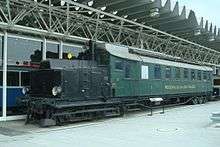
.svg.png)
.svg.png)